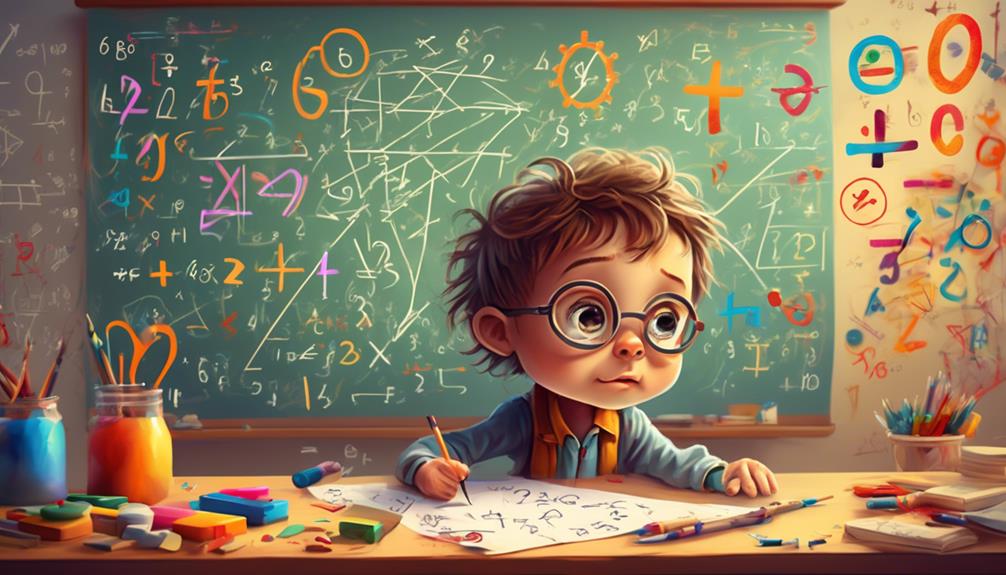Simplifying Complex Math Concepts for Young Learners

Discover practical strategies and techniques to simplify complex math concepts for young learners. This includes fractions, algebraic expressions, geometry, and more. These strategies will empower your child with the confidence to conquer math.
Breaking Down Fractions
Breaking down fractions may seem daunting at first, but fear not, as we're here to simplify the concept for you. Understanding fractions is crucial in many areas of mathematics, and it's not as complicated as it may appear.
Let's start by discussing equivalent fractions.
Equivalent fractions are different fractions that represent the same value. For example, 1/2 and 2/4 are equivalent because they both represent half of something. To find equivalent fractions, you can multiply or divide both the numerator and denominator by the same number. It's like finding different ways to express the same amount.
Now, let's move on to adding and subtracting fractions.
When adding or subtracting fractions, it's important to have a common denominator. The denominator represents the total number of equal parts a whole is divided into. To add or subtract fractions with different denominators, you need to find a common denominator by finding the least common multiple (LCM) of the two denominators.
Once you have a common denominator, you can easily add or subtract the numerators and keep the denominator the same.
Simplifying Algebraic Expressions
Simplifying algebraic expressions is a key skill that won't only make your math problems easier, but also help you gain a deeper understanding of how variables and numbers interact in equations. Here are four important things to keep in mind when simplifying algebraic expressions:
- Combine like terms: Look for terms that have the same variables and exponents, and combine them. For example, if you have 3x + 2x, you can simplify it to 5x.
- Distributive property: If you have an expression like 2(x + 3), you can simplify it by distributing the 2 to both terms inside the parentheses. It becomes 2x + 6.
- Simplifying quadratic equations: Quadratic equations involve variables raised to the power of 2. To simplify them, you can use techniques like factoring, completing the square, or using the quadratic formula.
- Simplifying radical expressions: Radical expressions involve square roots or other root operations. To simplify them, you can look for perfect squares or use rules of exponents to simplify the expression.
Understanding Geometry Basics
Geometry is a fascinating branch of mathematics that explores the properties and relationships of shapes and figures in both two and three dimensions. When it comes to understanding geometry basics, it's all about exploring geometric shapes and understanding spatial relationships. Let's dive into these concepts and make them easier to grasp.
Geometric shapes come in various forms, such as circles, squares, triangles, and rectangles. Each shape has its own unique attributes, like the number of sides, angles, and symmetry. To help you visualize these concepts, here's a handy table:
| Shape | Number of Sides | Number of Angles | Symmetry |
|---|---|---|---|
| Circle | Infinite | 0 | Infinite |
| Square | 4 | 4 | 4-fold |
| Triangle | 3 | 3 | 3-fold |
| Rectangle | 4 | 4 | 2-fold |
Understanding spatial relationships is about how shapes interact with one another. For example, you can determine if two shapes are congruent (same shape and size) or similar (same shape but different sizes). You can also explore how shapes fit together, like puzzle pieces, to form larger shapes.
Introducing Probability in Simple Terms
Now that you have a solid understanding of geometric shapes and spatial relationships, let's venture into the exciting world of probability and explore it in simple terms.
Probability is all about exploring random events and understanding likelihood and chance. Here are four key ideas to help you grasp this concept:
- Probability is a way of measuring how likely something is to happen. Imagine flipping a coin. You have a 50% chance of it landing on heads and a 50% chance of it landing on tails. Probability helps us understand the chances of different outcomes.
- Events can be classified as certain, likely, unlikely, or impossible. For example, it's certain that the sun will rise tomorrow. It's likely that you'll eat breakfast tomorrow. It's unlikely that you'll win the lottery. And it's impossible for a square to have rounded corners.
- Probability can be represented using fractions, decimals, or percentages. For instance, if there are 6 red marbles and 2 blue marbles in a bag, the probability of picking a red marble is 6/8, which can also be written as 0.75 or 75%.
- Probability can help us make predictions and informed decisions. By understanding the likelihood of certain events, we can evaluate risks and make choices based on the chances of things happening.
Exploring Measurement and Units
Let's dive into the fascinating world of measurement and units, where we explore the art of quantifying and comparing quantities. Measurement is all around us, from the length of our pencils to the weight of our backpacks. It helps us make sense of the world and understand how things relate to each other. But sometimes, it can be a bit confusing. That's why we're here to help you navigate through the world of measurement.
One important aspect of measurement is understanding scales. Scales help us compare different quantities and determine their relative sizes. Think about a map, for example. Maps use scales to show the distance between different places. By understanding the scale, you can figure out how far apart two cities are in real life.
Another important skill in measurement is exploring conversions. Conversions allow us to change one unit of measure into another. For example, you might need to convert miles into kilometers or ounces into grams. Understanding conversions helps us make sense of different units and compare quantities more easily.
Making Sense of Data Interpretation
Now it's time to tackle the important skill of making sense of data interpretation. Understanding graphical representations is key to deciphering information presented in charts and graphs.
You'll also learn how to analyze data patterns, spotting trends and making connections.
And most importantly, you'll learn how to interpret data accurately, making informed conclusions based on the information at hand.
Understanding Graphical Representations
Understanding graphical representations is a crucial skill for young learners as it allows them to make sense of data interpretation and draw meaningful conclusions. Here are four key aspects to consider when diving into this topic:
- Analyzing scatterplots: Scatterplots help young learners understand the relationship between two variables. By examining the pattern of points on the graph, they can identify if there's a positive, negative, or no relationship between the variables.
- Interpreting line graphs: Line graphs show the change in a variable over time. Young learners can analyze the slope of the line to determine if the variable is increasing or decreasing and at what rate.
- Identifying trends: Graphical representations help young learners identify trends or patterns in the data. They can observe if there are any outliers or if the data points cluster around a specific value.
- Making predictions: By studying graphical representations, young learners can make predictions about future data points based on the observed patterns. This skill allows them to apply their understanding and make informed decisions.
Mastering graphical representations empowers young learners to effectively analyze data and draw accurate conclusions, enabling them to become confident problem solvers.
Analyzing Data Patterns
When analyzing data patterns, young learners gain valuable insights into the interpretation of data and the ability to draw meaningful conclusions. Data analysis techniques allow them to make sense of complex information by identifying trends in data. By observing patterns and relationships, they can uncover important information that mightn't be immediately apparent.
For example, they might notice that as the temperature increases, ice cream sales also increase. This helps them understand the concept of cause and effect. They can also use data analysis techniques to compare different sets of data and make connections between them. This enables them to make informed decisions and predictions based on the information at hand.
Analyzing data patterns not only enhances their math skills but also equips them with valuable problem-solving and critical thinking abilities.
Interpreting Data Accurately
To accurately interpret data, you need to observe patterns and make connections between different sets of information. Here are four key points to help you improve your data interpretation skills:
- Interpreting statistical analysis: Statistical analysis involves analyzing numerical data to identify trends, patterns, and relationships. It helps you understand the significance of the data and draw meaningful conclusions.
- Differentiating between qualitative and quantitative data: Qualitative data is descriptive and subjective, while quantitative data is numerical and objective. Understanding the type of data you're working with is crucial for accurate interpretation.
- Look for outliers and anomalies: Outliers are data points that deviate significantly from the rest, and anomalies are unexpected or unusual observations. Identifying these can provide valuable insights and help you understand the underlying reasons.
- Consider the context: Always consider the context in which the data was collected. This includes understanding the purpose, the population being studied, and any external factors that may influence the data.
Demystifying Graphs and Charts
Graphs and charts may seem intimidating at first, but fear not – we're here to break them down and make them as clear as day! When it comes to interpreting visual data, graphs and charts are your best friends. They provide a visual representation of information that can help you understand complex ideas in a simple way.
Analyzing trends in graphs is all about recognizing patterns. Take line graphs, for example. They show how something changes over time. By looking at the slope of the line, you can determine if the values are increasing or decreasing. Is the line going up? That means the values are getting bigger. Is it going down? That means the values are getting smaller. It's like reading a story of numbers!
Bar graphs, on the other hand, are all about comparing different categories. The height of each bar represents the value for that category. You can easily see which category has the highest or lowest value just by comparing the heights of the bars. It's like a visual ranking system!
Mastering Problem-Solving Strategies
Are you ready to level up your problem-solving skills?
In this section, we'll explore effective techniques that will enhance your critical thinking abilities.
No more feeling overwhelmed or stuck when faced with a math problem.
Get ready to tackle them head-on and become a problem-solving pro!
Effective Problem-Solving Techniques
Wondering how to become a problem-solving master? Look no further! Here are four effective problem-solving techniques that will help you tackle even the most complex math concepts with ease:
- Break it down: When faced with a challenging problem, start by breaking it down into smaller, more manageable parts. This will help you grasp the problem's structure and identify any patterns or relationships.
- Use visual aids: Visualizing the problem can make it easier to understand and solve. Draw diagrams, create tables, or use manipulatives to represent the problem visually. This can provide valuable insights and help you see connections you might've missed otherwise.
- Think critically: Apply critical thinking techniques such as analyzing, evaluating, and reasoning to approach the problem from different angles. Consider different strategies, assess their effectiveness, and make informed decisions about the best approach to take.
- Practice, practice, practice: Problem-solving is a skill that improves with practice. Keep challenging yourself with a variety of problems, and don't be afraid to make mistakes. Learn from them and use them as opportunities to grow and refine your problem-solving strategies.
With these techniques in your toolbox, you'll be well on your way to becoming a problem-solving master!
Enhancing Critical Thinking Skills
To become a problem-solving master and enhance your critical thinking skills, it's essential to master various problem-solving strategies.
Developing a problem-solving mindset is key to fostering creative problem solving.
One effective strategy is breaking down complex problems into smaller, more manageable parts. This allows you to focus on each component individually, making it easier to find a solution.
Another strategy is using visual representations, such as diagrams or charts, to help you visualize the problem and identify patterns or relationships.
Additionally, practicing trial and error can help you explore different approaches and learn from your mistakes.
Remember, critical thinking isn't about finding the right answer immediately, but rather about analyzing, evaluating, and generating multiple solutions.
With practice and perseverance, you can become a problem-solving master and enhance your critical thinking skills.
Frequently Asked Questions
How Can I Help My Child Understand Fractions Without Using Complex Mathematical Terms?
You can simplify fractions for your child by comparing them to slices of pizza. Show them that one slice is one part out of a whole pizza. This helps them understand fractions without using complex terms.
Are There Any Tips or Tricks for Simplifying Algebraic Expressions?
To simplify algebraic expressions, start by combining like terms and using the distributive property. Avoid common mistakes like forgetting to multiply coefficients or combining terms incorrectly. Practice makes perfect, so keep at it!
What Are Some Real-Life Examples That Can Help Young Learners Understand Geometry Basics?
To help you understand geometry basics, think about real-life examples like building blocks and puzzles. Imagine how shapes fit together and how they create spaces. You can even use art and design to explore geometry!
Can You Explain Probability in Simple Terms Using Everyday Examples?
You can simplify probability by using everyday examples. Think of flipping a coin to understand the concept of chance. You can make learning fractions fun and engaging by baking cookies and dividing them up to share.
Are There Any Hands-On Activities or Games That Can Help Young Learners Explore Measurement and Units?
There are plenty of hands-on activities and engaging games that can help you explore measurement and units. From building towers with blocks to measuring ingredients while baking, you'll have fun while learning!










